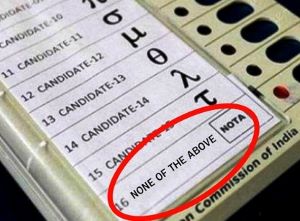I n a significant development amid a low voter turnout in the initial two phases of the ongoing general elections, the Supreme Court has sought a response from the Election Commission of India regarding the protocol to be followed if NOTA (none of the above) option surpasses the number of votes received by the candidates in a constituency or in other words, if NOTA receives the maximum votes. The top court has served a notice to the poll panel based on a PIL submitted by author, activist, and motivational speaker Shiv Khera. The petition called for establishment of regulations to invalidate an election and call for a fresh one in the event NOTA option garners more votes than any candidate.
It is pertinent to note that NOTA option is being provided to voters in all electronic voting machines (EVMs) in pursuance of a 2013 Supreme Court verdict that had held that “a provision of negative voting would be in the interest of promoting democracy as it would send clear signals to political parties and their candidates as to what the electorate thinks about them.”
In the current matter, a Bench comprising Chief Justice of India DY Chandrachud and Justices JB Pardiwala and Manoj Misra, at the outset, displayed hesitation to consider Khera’s PIL as they believed it fell within the realm of government policy. However, they eventually agreed to hear the case after senior advocate Gopal Shankaranarayanan, the petitioner’s counsel, pointed out that a BJP candidate in Surat had won uncontested due to other candidates withdrawing their nominations. The counsel argued that if the BJP nominee had run against NOTA option as a symbolic candidate, the true choice of the people would have been revealed.
The petition referred to the 170th report of the Law Commission of India of 29 May, 1999. The report suggests a new method of election where a candidate must receive at least 50 per cent of votes cast to be declared elected. It also proposes the option of a ‘negative vote’ for voters who do not wish to support any candidate. The recommendation includes counting negative votes as part of the total votes cast when determining the 50 per cent threshold. If no candidate reaches the 50 per cent mark in the initial election, a run-off should be held. If no candidate still reaches the threshold in the run-off, a fresh election should be conducted for that constituency.
Supporting the argument for re-election in the event of NOTA emerging as the winner, the plea stated that candidates should be disqualified from the electoral process if they receive fewer votes than NOTA. The PIL highlighted that since 2013, the introduction of NOTA has failed to serve its intended purpose of boosting voter turnout in elections. Furthermore, the PIL pointed out that NOTA has not compelled political parties to nominate candidates with clean backgrounds as is evident from the high number of candidates with criminal charges contesting elections in the country.
The NOTA option empowers voters to express their dissatisfaction and lack of support for all candidates. It gives them the right to reject while still turning out to vote. However, over a decade after it was introduced with all good intentions, the number of voters going for the option still remains low, with experts dubbing it as a toothless tiger having no implications on the results. NOTA had secured around 1.06 per cent of votes in the last Lok Sabha elections, and among the states, the highest was when it received 1.98 per cent of the total votes polled in the 2018 Chhattisgarh Assembly polls. It’s time the poll body gives more teeth to NOTA, a true weapon for electors who don’t belong to any vote bank and are often ignored by both the ruling and Opposition parties.






































